The Problem: Airports need to know if a flight is arriving later than its scheduled time, as that will impact operations and passenger services. A late-arriving flight may result in inadequate staffing at terminals and a poor passenger experience. The key challenge for airports is, they don’t often know a flight will be arriving late until it enters their airspace. Very often, airports resort to checking the status of flights manually through 3rd party resources or websites. This may mean too little time for airports to react and make informed decisions.
The Solution: Cirium offers real-time flight tracking and monitoring of flights globally. We curate flight status data from over 600 data sources. Using Cirium’s Flex API services, airports can stay on top of changes of the flights, at origins or throughout journeys. An airport can choose to “pull” the info by calling Cirium Flight Status API based on frequency needs, or receive them as “push” alerts using Cirium Flight Alerts API tailored to relevant flight events, on a real-time basis. There are 20 flight events to select from, including cancellation, diversions, delays, tail number changes, gate changes and more.
If an airport wants to track a group of flights instead of individual flight, they can use Operational Batch Alerts to monitor a large group of flights and receive relevant alerts throughout the day through a combination of specific airlines, departure or arrival airports. With the current pandemic situation, many airlines choose to cancel flights at the last minute. This solution will help airports gain early awareness of any flight deviations or irregular operations.
Key features of Operation Batch Alerts:
- Intelligence; a real-time push of flight status updates by a group of flights
- Timely notice of schedule exceptions and irregular operations across a group of flights
- Notify users of specific events across group of flights while filtering out irrelevant notifications
- Easy and simple flight notification rule configuration via the API
Airports face challenges in providing complete arrival flight information to passengers. They can offer updates on departure flights at their airports, however may not have visibility on inbound flights from origin airports. In some cases, airports do not have the API capability to transmit their flight data into their digital channels such as mobile application and websites. Cirium’s Flex API services can help to overcome this issue and power airports’ channels with real-time flight updates.
Below are two airports in APAC who use Cirium Flight Status API to display status of the arrival flights via their mobile application and website.
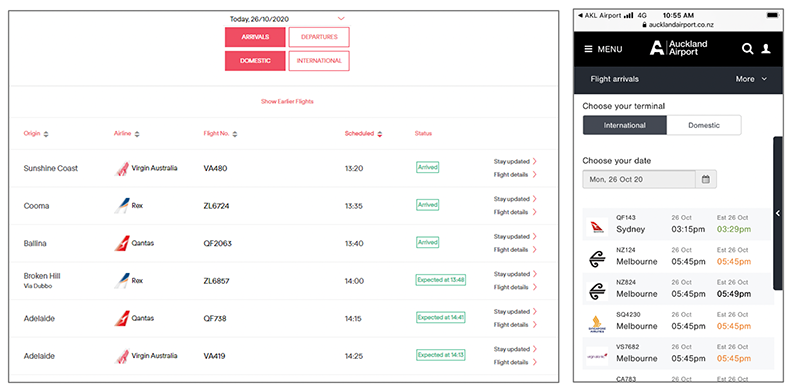
Cirium helps airports determine greater accuracy in billings for landing and usage fees
The Problem: Airports struggle with compiling landing and usage fee bills for airline tenants utilizing their airports. Airports currently rely on reports submitted by tenants based on published schedules. However, airports have noticed some airlines routinely operate different aircraft than indicated in schedules on specific flights. This results in airports not billing for and collecting correct fees from airlines.
The Solution: Cirium can deliver historical flight data for an accurate audit on the reports submitted by airlines. Using Cirium’s Premium Airport Analysis Workbook, users retrieve details of flights historically flown in and out of an airport. The Workbook offers multiple dashboard views to address different analytical needs for airports. Two dashboards are particularly useful to airports in understanding aircraft landing and usages: Arriving/Departing Flights and Gate Utilization by Airline.
Cirium’s Arriving/Departing Flights dashboard shows historical flights flown in or out of a specific airport. User may refer to graphical bars charts on this dashboard to understand the number of flights arriving/departing at the airport, broken down by hours of the day across a date range. Each bar also indicates the breakdown of flights that have landed, cancelled, diverted, etc., which are color-coded. To find greater flight detail, users can refer to the table list on the right of the dashboard which includes details such as flight number, tail number, scheduled departure/arrival time, estimated or actual departure/arrival time, delays, and, more importantly the actual aircraft equipment used for the flight (highlighted in the red box below). This is extremely useful to airports in determining the total weight of the each aircraft that landed at their airports.

Other than landed weight of the aircraft, airports could charge different rates based on where aircrafts are parked (e.g. at a specific terminal or gates). The Cirium Gate Utilization by Airline dashboard shows the overall utilization of gates by different airlines at a specific airport. Users can readily determine the number of aircrafts parked at different gates, across different terminals, across a date range (highlighted in the left red box below). Users may also identify where airlines parked aircraft by airline groupings and turns at each gate (highlighted in the blue box below).
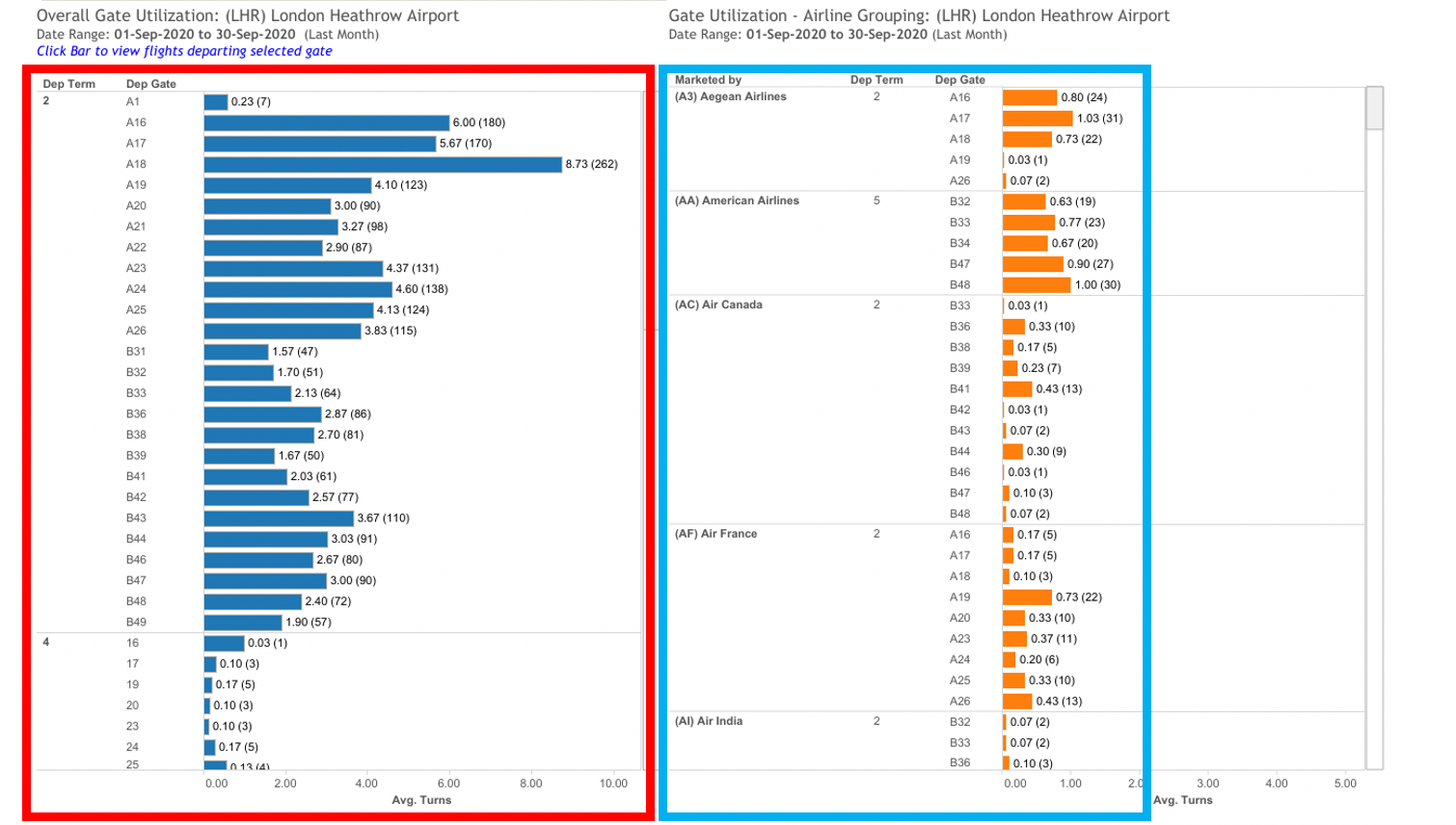
Cirium helps lounge operators forecast potential premium demand
The Problem: Premium lounge operators require greater insights. It’s a constant struggle especially for large operators to gauge potential demand for premium lounges. Operators would like to be able to forecast the number of customers who may visit, in an effort to right size supply chains, staffing and reduce costs and spoilage.
The Solution: Cirium can deliver airport historical customer informatics to lounge operators to use as an input into planning and forecasting. Using Cirium’s FM-Traffic database, users can determine how many premium-fared passengers have historically flown from an airport. Using this information, the lounge operator can make demand assumptions from the premium passengers (in addition to “other” passengers who may purchase access).
For example, one data pull finds all passengers for an airport (Los Angeles-LAX, in this case) for the months of May and June 2019. We would likely use these months to forecast May and June of 2020 (in a non-COVID-19 world). We then select the IATA code for the airline a lounge serves.
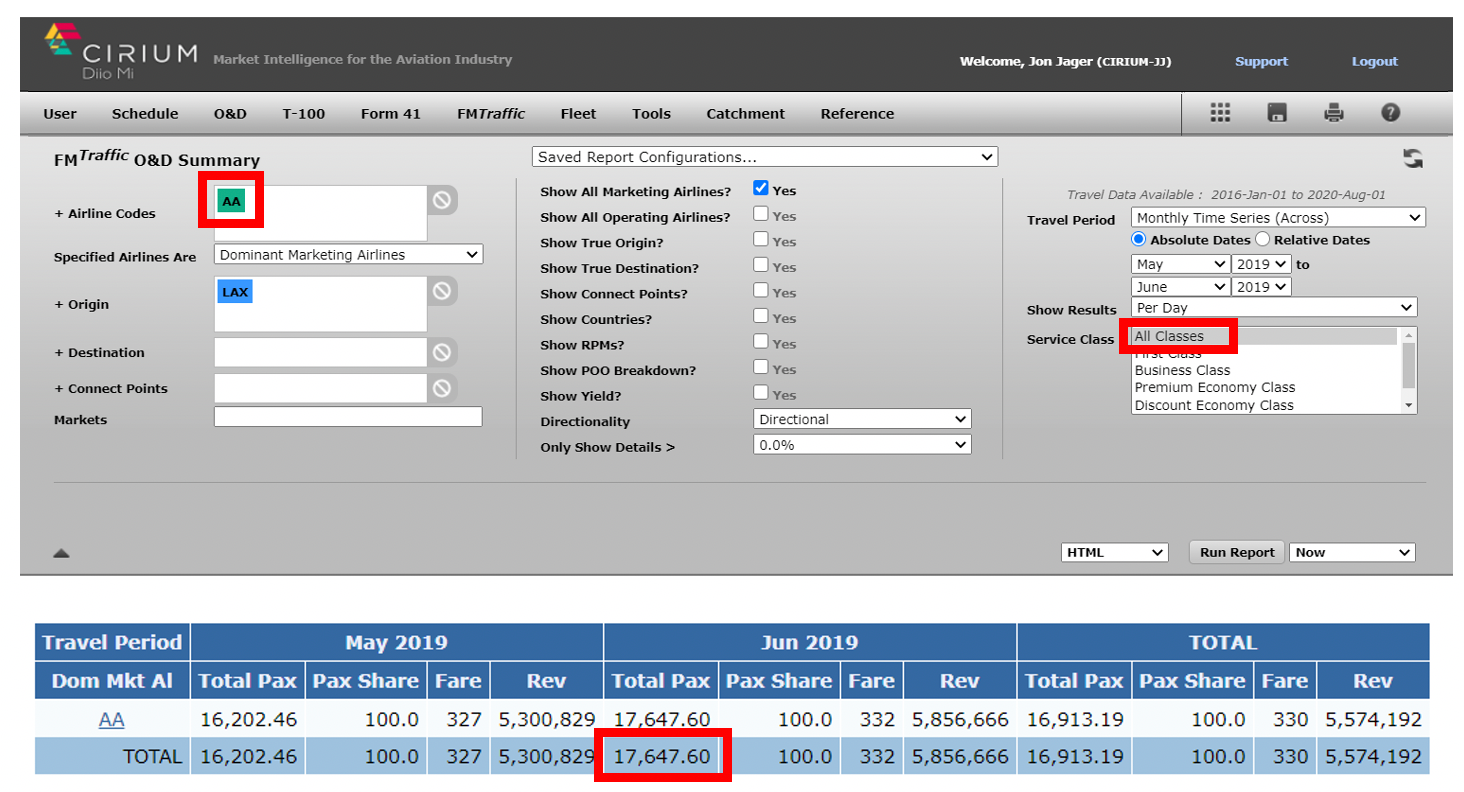
We see an airline had an average of 17,647 total departing passengers per day, in June 2019. Now we need to determine how many of that set would have access to a particular lounge by virtue of being a first or business class ticketed passenger.

With a second data pull for only First Class and Business Class passengers, we see 1,324 of American Airlines’ 17,647 daily passengers (or 8%) could potentially require lounge access—and that is not factoring economy passengers who may have access through other means.
Users may repeat this exercise, to refine results for international passengers only, in the event the lounge is only available to them.
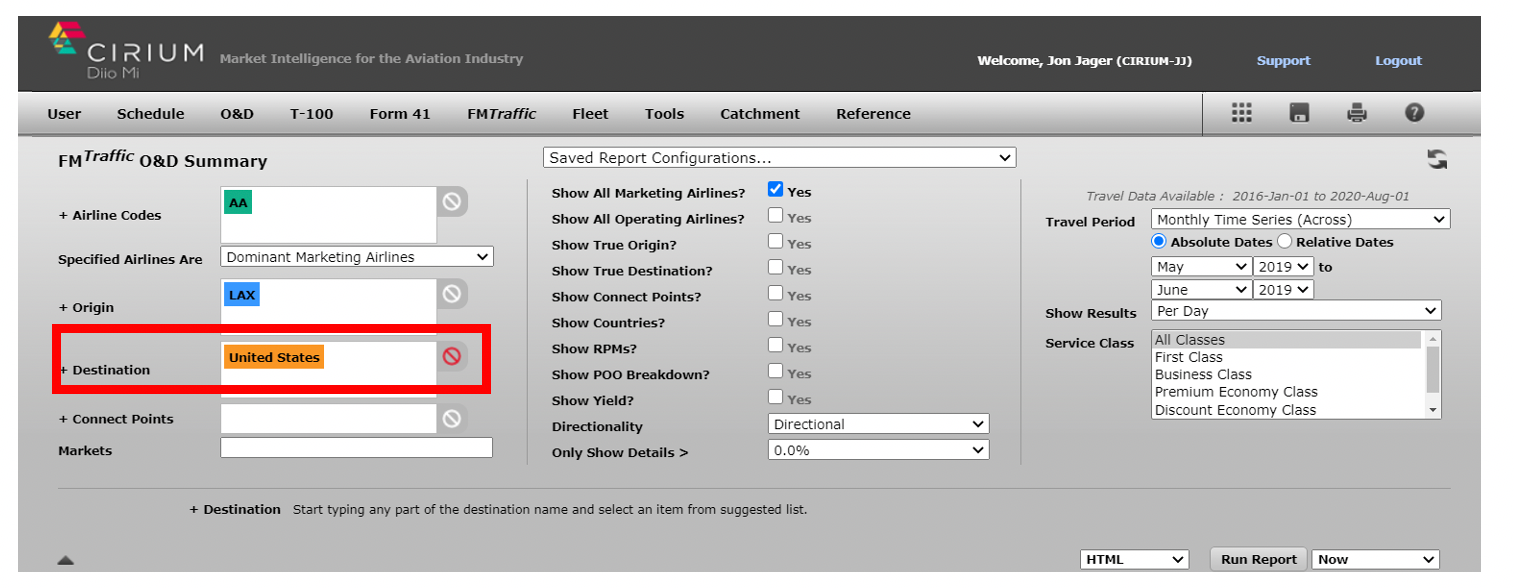
Cirium helps security services at airports determine times of day when there may be peak demand at checkpoints, allowing for adequate staff preparation
The Problem: Airports struggle at times with long lines at security checkpoints while other checkpoints are empty at the same time. Long security lines may cause issues for both travelers and security staff.
The Solution: Cirium delivers detailed information concerning the number of departures—and departing seats, per hour of the day at any given airport. By utilizing the Level of Ops Report in either Cirium SRS Analyser or Cirium Diio Mi, users determine when security lines may be busy, and can staff checkpoints appropriately. The below example shows Dallas-Love Field has some clear-cut “busy hours” during the day and the security agency can use this data to appropriately staff for potential demand a few hours before these departures.

This is probably the most simple case, as Dallas-Love Field is a small, one-terminal airport. What about airports with multiple terminals like Phoenix Sky Harbor?
A little bit of research tells us that American Airlines, British Airways, Condor Airlines, Southwest Airlines, Volaris, and WestJet operate at Terminal 4, with a number of other airlines operating from Terminal 3. The user of the Level of Ops report can easily filter for airlines in Cirium SRS Analyser or Cirium DiioMi and find potential “busy times” in each terminal. The below example will give those staffing checkpoints in Terminal 4 an idea of when they may expect longer lines—unless they staff to appropriately handle the crowds.

This exercise can be repeated for airlines operating from Terminal 3. If able, the security organization can move staff from one terminal to the other, if the potential for checkpoint congestion differs by terminal.
Cirium can help airports plan airside expansion
The Problem: Airports struggle with expansion planning. An airport handled about 900K passengers last year. This year the airport projects a slight increase in passenger volume. Airport capacity has been reached and the need to explore runway expansion, terminal building and apron to accommodate for much larger wide body aircraft to carry more passengers. In this scenario, the airport has already expanded the airport twice prior to recruiting new airlines to serve the airport. They would like to be able to forecast the number of passengers coming through and be able to adequately supply the demand, not just for the short term but for the long term too.
The Solution: Cirium can deliver airport historical scheduled and traffic information to use as an input into expansion planning. Using Cirium’s FM-Traffic database, the user can look at historical trends of carriers flying into the airport, going back to 2014, broken down by airline, passenger share, pax volumes in/out of any specific airport among other granular points via the O&D report and selecting the ‘Annual Time Series’ for the travel period. Using this information, lounge operators can make assumptions as to the demand of airport facilities such as the terminal and gates. Users can also determine how long and what kind of material to use to construct and expand the runway and apron, to accommodate larger aircraft.
The data pull shown below sorts out passenger numbers flying into an airport since 2016 (Kigali International Airport-KGL, in this case). This historical yearly trend analysis can help to forecast passenger numbers into KGL for the next 5 years ahead.

In this example, KGL airport had an average increase of 81,584 in total passengers per year from 2016 to 2019. This helps to gauge expansion of airport facilities (apron, gates, terminal, runway and car park).
Cirium helps airport hotels determine times of day when there may be peak demand for rooms, gyms or shower facilities to prepare for adequate staffing and provision of services
The Problem: Airports struggle with hotel planning. An airport is struggling to find a fine balance between supply and demand for hotel facilities. Additionally, it may be difficult to plan hotel maintenance during down time periods when guest numbers are low, to allow infrastructure improvements without significantly affecting guest services.
The Solution: Cirium delivers detailed information concerning the number of arrivals—and arriving seats, per hour of the day at any given airport. By utilizing the Level of Ops Report in either Cirium SRS Analyser or Cirim DiioMi, users can readily see when an airport is scheduled to be busy so as to plan their resources appropriately, including staff, quantity of rooms and other leisure and business facilities for guests. The Level of Ops Report below shows London Gatwick airport-LGW has some clear-cut “busy hours” during the day.
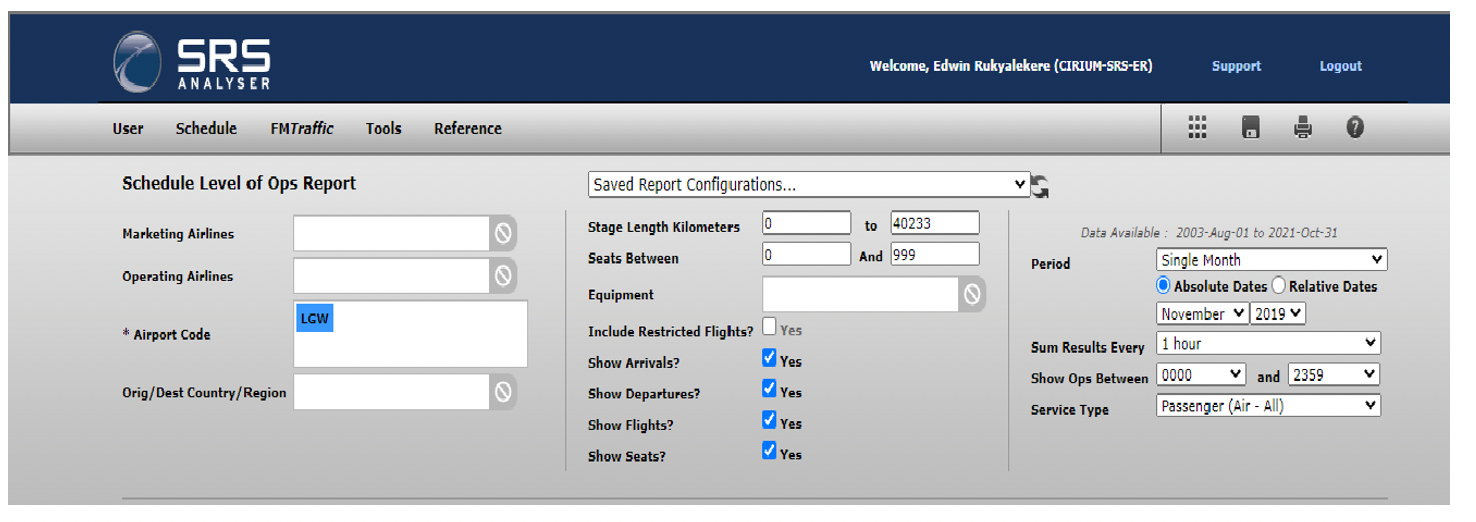
The results populated below show LGW is scheduled to have the highest number of arriving scheduled seats for the month of December 2020 at 8am, 9pm and 10pm local time.
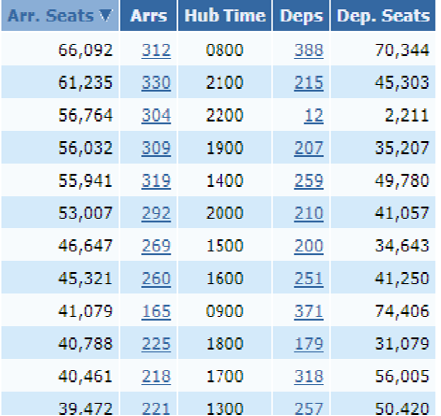
Users may then increase key facilities such as room inventory availability, and, maintenance of the airport hotel ahead of time.

























































